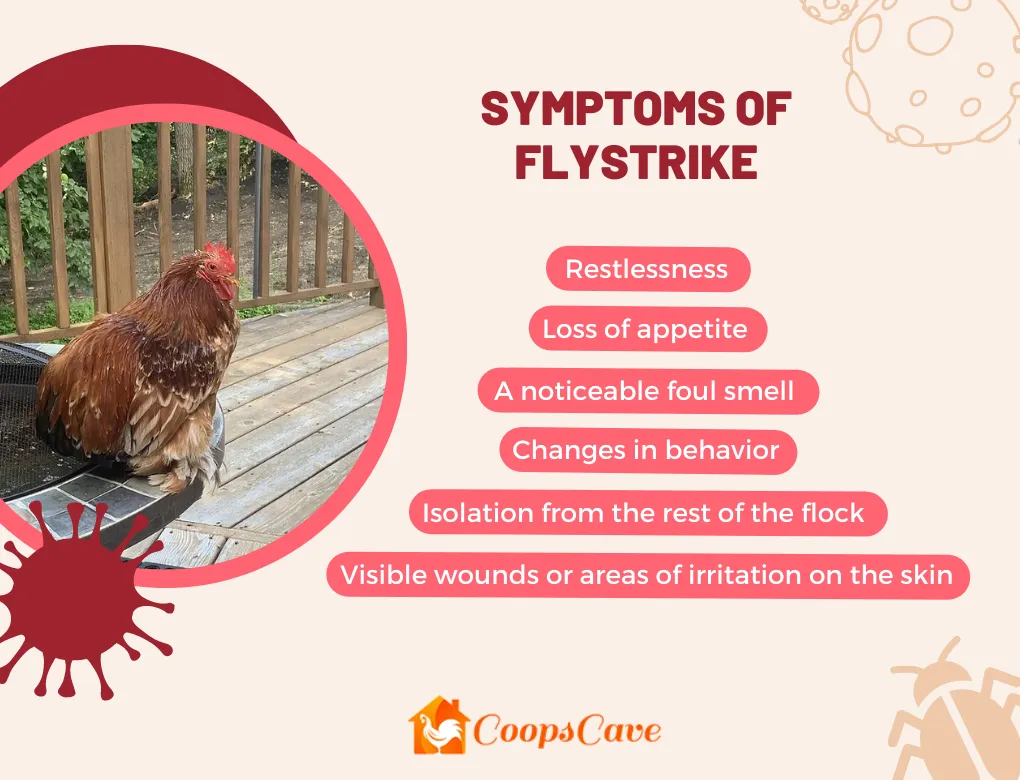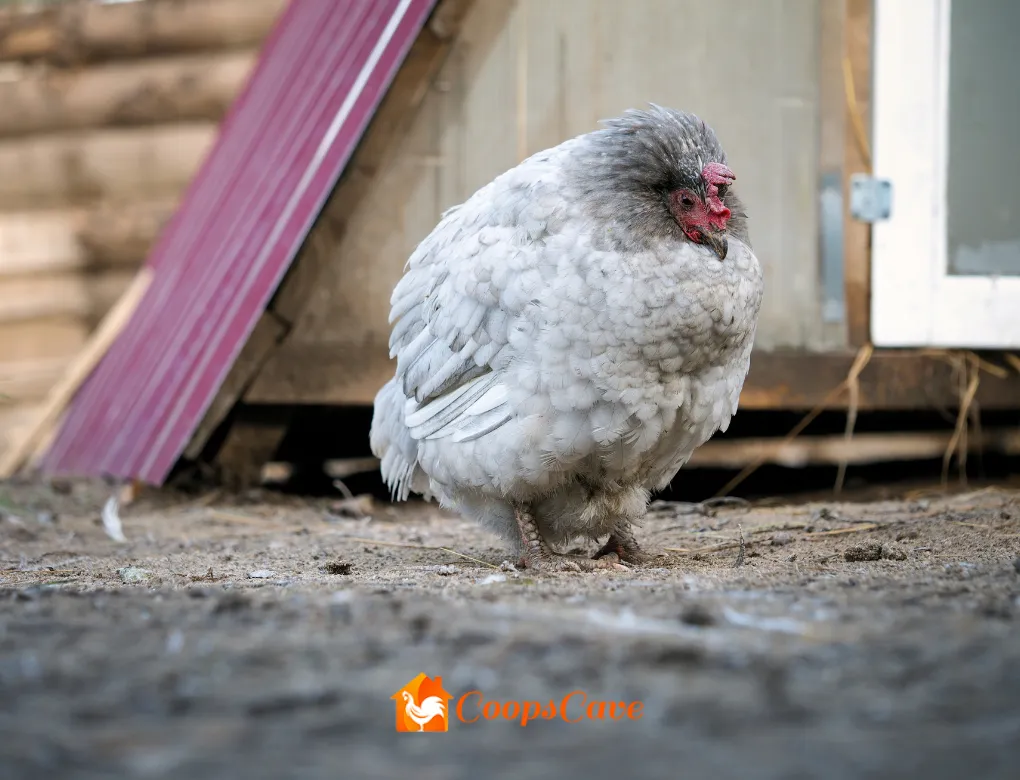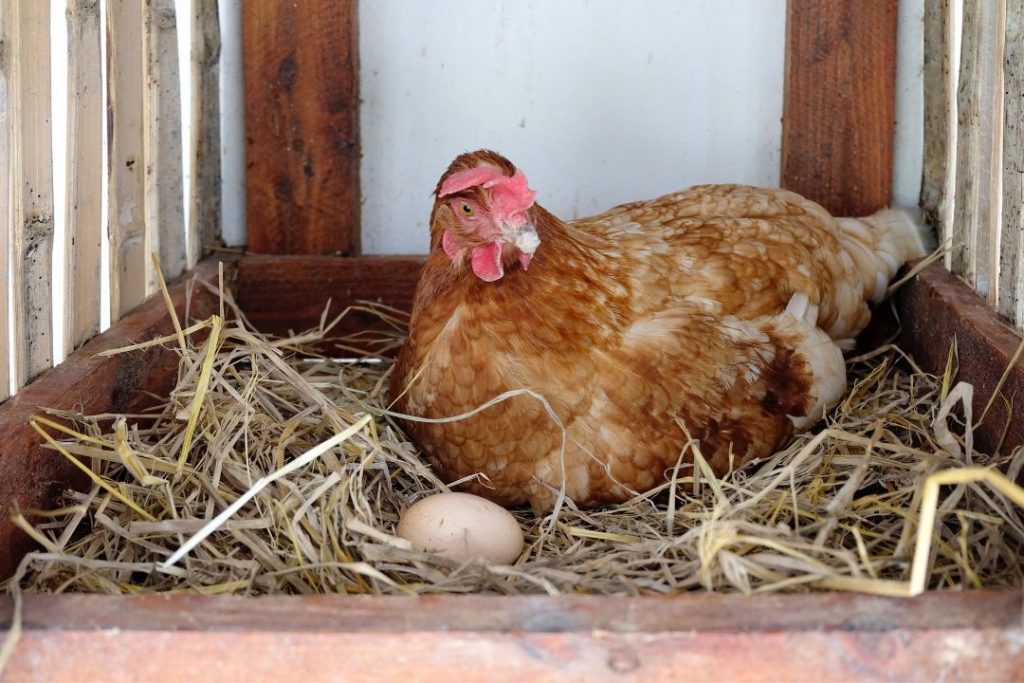How common is flystrike in chickens? This query plagues many poultry enthusiasts. Flystrike is a situation where flies lay eggs on a chicken’s skin. It’s a serious concern that can lead to your bird’s severe health issues.
Common symptoms of flystrike are restlessness, loss of appetite, visible wounds, change in behavior, etc. Irrespective of geographic location, climate, and living conditions, the prevalence of flystrike is very common in chickens.
The major risk factors of flystrike are warm and humid weather, poor hygiene, existing wounds or infections, etc.
In this comprehensive guide, we’ll explore the frequency of flystrike in chickens. This article will also guide you through the risk factors contributing to this condition. We will provide an in-depth understanding of flystrike. This knowledge can help you protect your flock effectively.
What Is Flystrike?
Flystrike is a parasitic condition. Also, it is known as myiasis. It affects numerous animals, including chickens.
It’s a potentially life-threatening and severe condition. This condition in your chiken requires immediate attention and treatment.
How Does Flystrike Occur?
Flystrike occurs when flies lay their eggs on a chicken’s skin. Typically, it occurs in areas where your chicken’s skin is damaged or soiled, such as open wounds or areas covered in feces.
Once the flies lay eggs, the eggs hatch into larvae. The larvae are commonly known as maggots. Within a very short period these start to feed on your bird’s tissue. This feeding process causes the symptoms and potential health complications associated with flystrike.
Understanding Symptoms Of Flystrike

Flystrike, or myiasis, is a parasitic condition affecting various animals, including chickens.
However, common signs include:
- Restlessness
- Loss of appetite
- A noticeable foul smell
- Changes in behavior
- Isolation from the rest of the flock
- Visible wounds or areas of irritation on the skin
The affected area may also appear red and inflamed. In severe cases, you may see maggots on the chicken’s skin.
How Common Is Flystrike In Chickens?
Flystrike is, unfortunately, a common issue in chickens. Its occurrence is exceptionally high during warmer months. This is when flies, the culprits of flystrike, are most active. The exact prevalence can differ based on several factors.
Geographical location is a crucial factor. Areas with high fly populations naturally see more cases of flystrike. The climate also plays a role. Warm and humid conditions in which flies thrive tend to have higher instances of flystrike.
The living conditions of the chickens also influence the prevalence. Chickens in unclean environments or those in poor health are more susceptible. This is because flies are attracted to waste and unhealthy chickens.
In conclusion, while flystrike is common, it can be managed. Understanding the factors that contribute to its prevalence can help in its prevention. Several factors contribute to this variation.
1. Geographical Location
The location of your chicken coop plays a significant role. Areas with high fly populations see more cases of flystrike. This is a natural consequence of the increased number of flies.
2. Climate
The climate is another crucial factor. Flies are more active in warm and humid conditions. Therefore, these climates see a higher prevalence of flystrike.
3. Living Conditions
The living conditions of your chickens also influence flystrike prevalence. Chickens in unclean environments are more likely to get flystrike. This is because flies are attracted to waste and filth. Chickens in poor health are also more susceptible. Their weakened state makes them an easy target for flies.
Flystrike is a common issue. It’s influenced by location, climate, and living conditions. Understanding these factors can help in managing and preventing flystrike.
Risk Factors For Flystrike
If you understand the flystrike risk factors, it will help you to take preventive measures. The most common risk factors are:
1. Warm and Humid Weather
Flies thrive in warm, humid conditions. Therefore, chickens are at a higher risk of flystrike during the summer months or in tropical climates.
During these periods, it’s essential to take preventative measures and regularly check your chickens for signs of flystrike.
2. Poor Hygiene
Chickens living in unclean conditions are more susceptible to flystrike. Flies are attracted to feces and other waste materials, which can increase the risk of flystrike.
Regularly cleaning your chicken coop and ensuring that your chickens are clean can significantly reduce the risk.
3. Existing Wounds Or Infections
Your chickens are more susceptible to flystrike if they already have sores or diseases. These places draw flies, making them great locations for egg-laying.
Routine health checks can decrease The risk of flystrike, which can aid in the early discovery and treatment of wounds or infections.
Preventing Flystrike In Chickens
Prevention is always preferable to treatment. Here are some things you can take to keep your flock fly-free:
1. Maintain Clean Living Conditions
Regularly clean your chicken coop and remove any waste materials. This can help deter flies and reduce the risk of flystrike.
It’s also essential to ensure that your chickens are clean, as flies are particularly attracted to chickens with soiled feathers.
2. Regular Health Checks
Regularly check your chickens for any signs of wounds or infections. Early detection and treatment can help prevent flystrike.
3. Using Insect Repellents
A fly barrier could be helpful around your chicken coop. These can aid in repelling flies and lessen the possibility of flystrike.
Fly deterrents in various forms are sprays, traps, and electronic gadgets. Pick an insect repellent that works in your unique setting while being safe for your chickens.
Treatment Of Chicken Fly Strike
You must respond fast if you think your chicken has a flystrike. The first step is to separate the afflicted hen from the rest of the flock to stop spreading flies. After that, clean the affected chicken’s afflicted region using warm water and a mild disinfectant.
Also, remove any visible larvae using Tweezers. It’s crucial to be careful throughout this process to prevent the chicken from becoming more upset or hurt.
It is essential to get veterinarian treatment if the condition is severe or you are unclear on how to clean and treat the affected region properly. The doctor can advise medicines to avoid infection and painkillers to help the chicken feel better.
Treating flystrike in chickens requires immediate and thorough action. The process involves several steps.
1. Removal of Larvae
The first step is to remove all visible larvae. This should be done carefully to avoid causing further harm to your chicken.
2. Surgical Debridement
Next, the infested wound bed needs surgical debridement. This process involves removing damaged, infected, or dead tissue to develop the healing probability of the remaining healthy tissue.
3. Daily Dressing Changes
Consistent dressing changes on a daily basis are crucial. This helps to keep the wound clean and promotes healing.
4. Irrigation of the Wound
Irrigation may be necessary for wounds with holes and cavities where maggots can hide. This involves flushing the wound with a solution to clean and remove any remaining larvae.
5. Careful Removal
During the removal process, care should be taken not to rupture any maggots. Ruptured maggots can cause further complications.
6. Use of Chloroform in Olive Oil
A solution of 15% chloroform in olive oil or another oil can help to immobilize the larvae. This can make their removal more accessible and safer.
7. Physical Removal of Each Maggot
Each maggot must be physically removed rather than just killed with a topical agent. Dead maggots left inside the bird can cause secondary bacterial infection.
8. Monitoring for Complications
After treatment, it’s important to monitor for complications. These can include local destruction, invasion into deep tissues, and secondary bacterial infection.
Treating flystrike in chickens is a complex process that requires careful and immediate action. It’s always best to seek veterinary advice if you suspect a flystrike in your flock.
Final Thoughts
So, how common is flystrike in chickens? It’s, unfortunately, quite common. However, proper care and preventative measures can significantly reduce the risk.
Always remember, a clean coop and healthy chickens are your best defense against flystrike. By understanding the risk factors and signs of flystrike, you can ensure that your chickens remain healthy and happy.



